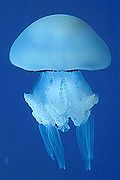| Rhizostomeae | |
|---|---|
 | |
| Phyllorhiza punctata | |
| Scientific classification | |
| Kingdom: | Animalia |
| Phylum: | Cnidaria |
| Class: | Scyphozoa |
| Subclass: | Discomedusae |
| Order: | Rhizostomeae Cuvier, 1799 |
Rhizostomeae is an order of jellyfish. Species of this order have neither tentacles nor other structures at the bell's edges. Instead, they have eight highly branched oral arms, along which there are suctorial minimouth orifices. (This is in contrast to other scyphozoans, which have four of these arms.) These oral arms become fused as they approach the central part of the jellyfish. The mouth of the animal is also subdivided into minute pores that are linked to coelenteron.






